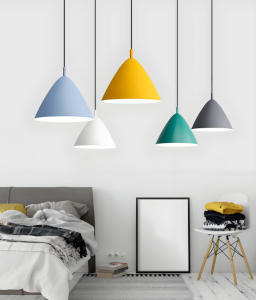Bringing Elegance Home: The Allure of a Chandelier
Chandeliers have a long history dating back to medieval times. The term “chandelier” originates from the French word “chandelle,” meaning candle. Initially, chandeliers were functional candle holders and symbols of wealth, commonly found in noble homes to illuminate large spaces.
Early chandeliers were crafted from wood, iron, or brass, featuring intricate designs. Over time, chandeliers evolved from purely functional objects to symbols of luxury. The 18th century saw the introduction of crystal prisms, enhancing light emission and adding sparkle.
Chandeliers became status symbols in wealthy homes and grand buildings. Their design continued to evolve with the advent of gas lighting in the 19th century and electric lighting in the 20th century. Modern chandeliers are available in various styles, materials, and sizes, making them versatile lighting fixtures suitable for diverse interior designs.
They have transitioned from simple candle holders to elegant, luxurious fixtures that enhance the ambiance of any space. Chandeliers remain popular in interior lighting, demonstrating their enduring appeal and adaptability over centuries.
Choosing the Perfect Chandelier for Your Space: Size, Style, and Placement
Size Matters
When selecting a chandelier, size is a crucial factor to consider. A chandelier that is too small will look out of place, while one that is too large can overwhelm the space. To determine the right size, consider the dimensions of the room and the height of the ceiling. A general rule of thumb is to add the length and width of the room in feet and convert that number to inches to get an approximate diameter for your chandelier.
Style and Aesthetic
In addition to size, the style of the chandelier should complement the overall design aesthetic of the room. Whether you prefer a traditional crystal chandelier or a modern minimalist design, there are countless styles to choose from. Consider the existing decor and furniture in the room to ensure that the chandelier will enhance the space rather than clash with it.
Placement is Key
Proper placement is essential when it comes to installing a chandelier. It should be positioned at an appropriate height, typically around 30-36 inches above a dining table or 7-8 feet above the floor in a living room or foyer. This will ensure that the chandelier becomes a focal point in the room without obstructing views or creating an imbalance in the space.
By taking these factors into account, you can select a chandelier that not only illuminates your space but also enhances its overall aesthetic.
The Impact of Chandeliers on Interior Design: Creating a Statement Piece
Chandeliers have a significant impact on interior design, as they have the ability to create a statement piece in any room. Whether it’s a grand crystal chandelier in a formal dining room or a sleek modern design in a contemporary living space, chandeliers can set the tone for the entire room. They add an element of luxury and sophistication while also providing ambient lighting that enhances the overall atmosphere.
A well-chosen chandelier can become the focal point of a room, drawing attention and adding visual interest. In addition to their aesthetic impact, chandeliers also have practical benefits when it comes to interior design. They provide ambient lighting that can create a warm and inviting atmosphere, making them an essential element in any well-designed space.
Chandeliers can also help to define different areas within a room, such as a dining area or seating area, by providing focused illumination. Their versatility allows them to be used in various rooms throughout the home, from grand entryways to cozy bedrooms, making them an essential element in interior design. Chandeliers have a lasting impact on interior design, creating a statement piece that adds both visual appeal and practical functionality to any space.
Their ability to set the tone for a room and provide ambient lighting makes them an essential element in creating well-designed interiors.
Maintenance and Care for Your Chandelier: Keeping it Sparkling and Beautiful
Proper maintenance and care are essential for keeping your chandelier sparkling and beautiful. Regular cleaning is crucial to ensure that your chandelier maintains its shine and sparkle. Dust and dirt can accumulate on the surface of the chandelier, dulling its appearance over time.
To clean your chandelier, start by turning off the power to the fixture and allowing it to cool down if it has been recently used. Use a soft microfiber cloth or duster to gently remove any dust or dirt from the surface of the chandelier. For more thorough cleaning, you can use a solution of mild dish soap and water to gently wipe down each crystal or glass piece.
In addition to regular cleaning, it’s important to inspect your chandelier for any loose or damaged parts. Check for loose crystals or broken pieces and tighten any loose screws or connections. If you notice any damage, it’s important to address it promptly to prevent further issues.
Finally, consider scheduling professional maintenance for your chandelier at least once a year. A professional can inspect and clean your chandelier thoroughly, ensuring that it remains in optimal condition for years to come. Maintaining and caring for your chandelier is essential for keeping it sparkling and beautiful.
By following regular cleaning routines and addressing any issues promptly, you can ensure that your chandelier remains a stunning focal point in your home.
The Versatility of Chandeliers: From Traditional to Contemporary Spaces
One of the most appealing aspects of chandeliers is their versatility, as they can complement a wide range of interior design styles from traditional to contemporary spaces. Traditional chandeliers with intricate designs and crystal embellishments are perfect for adding a touch of elegance to formal dining rooms or grand entryways. Their timeless appeal makes them a popular choice for classic interior designs that prioritize luxury and opulence.
On the other hand, contemporary chandeliers offer sleek and modern designs that are well-suited for minimalist or industrial spaces. These chandeliers often feature clean lines, geometric shapes, and innovative materials such as metal or glass. They can add a touch of sophistication to modern living rooms or kitchens while providing functional ambient lighting.
In addition to traditional and contemporary styles, there are also transitional chandeliers that blend elements of both traditional and modern designs. These versatile fixtures are perfect for spaces that combine different design aesthetics or for homeowners who appreciate classic elegance with a modern twist. The versatility of chandeliers makes them an ideal lighting choice for any interior design style, from traditional to contemporary spaces.
Whether you prefer classic elegance or modern sophistication, there is a chandelier style that can enhance your space and create a stunning focal point.
DIY Chandelier Installation: Tips for Hanging Your Chandelier Safely and Securely
Pre-Installation Precautions
Before you begin installation, it’s essential to turn off the power to the fixture at the circuit breaker to prevent any electrical accidents. Next, carefully read through the installation instructions provided by the manufacturer to ensure that you have all the necessary tools and hardware.
Determining Chandelier Placement
When determining the placement of your chandelier, consider the height of the ceiling and any obstructions such as furniture or decor that may interfere with its placement. Use a stud finder to locate ceiling joists or use an anchor if you are unable to secure the chandelier directly into a joist. It’s crucial to use appropriate hardware that can support the weight of your chandelier to prevent it from falling.
Securing and Wiring Your Chandelier
Once you have secured the mounting bracket or support system, carefully follow the manufacturer’s instructions for wiring and hanging your chandelier. Take your time to ensure that all connections are secure and that the fixture is level before turning on the power. If you are unsure about any aspect of installation, consider consulting with a professional electrician or contractor for assistance.
By following these tips for DIY chandelier installation, you can hang your fixture safely and securely while adding a stunning focal point to your space.
The Future of Chandeliers: Incorporating Smart Technology and Energy Efficiency
As technology continues to advance, the future of chandeliers is evolving to incorporate smart technology and energy efficiency. Smart chandeliers are equipped with features such as dimmable LED lights, remote control operation, and compatibility with smart home systems such as Alexa or Google Home. These features allow homeowners to customize their lighting experience and control their chandeliers with ease.
In addition to smart technology, energy efficiency is also becoming an important consideration for chandelier design. LED lighting has become increasingly popular due to its energy-saving benefits and long lifespan. Many modern chandeliers are now designed with integrated LED lights that provide bright illumination while consuming less energy than traditional incandescent bulbs.
Furthermore, sustainable materials such as recycled glass or metal are being used in chandelier construction to reduce environmental impact. Manufacturers are also exploring innovative designs that maximize natural light sources or incorporate renewable energy technologies such as solar power. The future of chandeliers is bright with advancements in smart technology and energy efficiency that offer homeowners greater control over their lighting experience while reducing environmental impact.
As these trends continue to develop, we can expect to see even more innovative designs that combine style, functionality, and sustainability in chandelier design.


